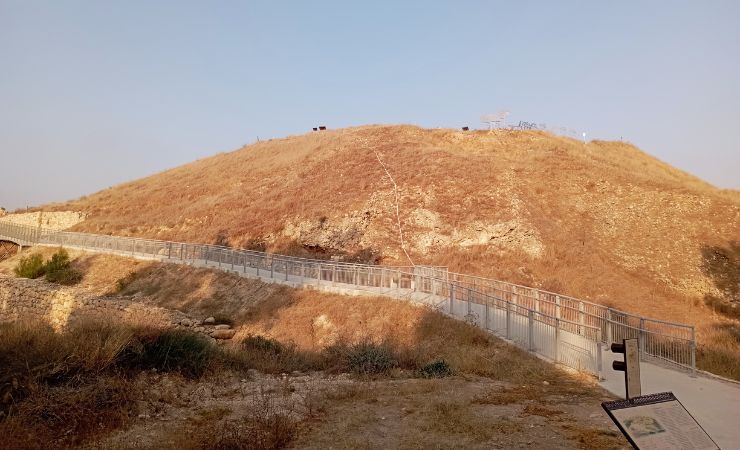Tel Lachish: The Ancient Secrets of Judah's Mighty Fortress
Tel Lachish is a fascinating archaeological site located in Judean foothills that bears witness to the ancient Kingdom of Judah’s glory and its turbulent past.

Location
Tel Lachish is located in the Shephelah region of Israel, roughly 40 kilometers southwest of Jerusalem and about 25 kilometers from the Mediterranean coast.
Biblical context
The passage details the Assyrian King Sennacherib’s campaign against Judah, focusing on how Hezekiah attempted to appease Sennacherib by paying a heavy tribute, only for the Assyrians to continue their advance toward Jerusalem.



The Site's History
Tel Lachish’s origins date to the Canaanite period during the Middle Bronze Age (around 1800 BCE), when it first rose to prominence. As a key player in the region, Lachish was heavily fortified and became a hub of political and economic power, its inhabitants thriving off trade routes that crisscrossed the land. Imposing walls, a grand palace, and a Canaanite temple all spoke to the city’s significance during this early period.
With the arrival of the Israelites, Lachish became part of the Kingdom of Judah, and by the 9th century BCE, it had transformed into one of Judah’s most critical cities, second only to Jerusalem. King Hezekiah, aware of the looming threat from the powerful Assyrian Empire, reinforced Lachish’s defenses, expanding the walls and constructing massive fortifications to hold off any invaders. But the threat materialized in 701 BCE, when King Sennacherib of Assyria marched his army into Judah, determined to quash the rebellion Hezekiah had incited by refusing to pay tribute. Lachish became the site of one of the most intense battles of the ancient world, as Sennacherib’s forces besieged the city. The siege, famously depicted in the Lachish Reliefs in Nineveh, was a brutal one. The Assyrians built a massive siege ramp, attacking the city’s walls with battering rams while its inhabitants fought desperately to hold them back. Despite their efforts, the city fell, and the Assyrians exacted a harsh punishment, destroying Lachish, deporting its people, and leaving behind a smoldering ruin.
Though devastated, Lachish was not left in ruin for long. It was rebuilt during the late 7th century BCE and once again fortified, this time against the looming Babylonian threat. In 586 BCE, the Babylonians, under King Nebuchadnezzar, launched their own campaign against Judah. The city held out as one of Judah’s last bastions of resistance, but like before, it fell after a brutal siege, marking the end of Judah’s independence as the Babylonians destroyed Jerusalem shortly afterward. Unlike its previous resurrection, Lachish would never fully recover after the Babylonian conquest. Although it saw some habitation during the Persian and Hellenistic periods, the once-great city began to fade from historical relevance, eventually becoming little more than a small village during the Roman and Byzantine eras.

Lachish's Assault by King Sennacherib
The Historical Background
In the late 8th century BCE, the Assyrian Empire was at the height of its power, with King Sennacherib as one of its most formidable rulers. Sennacherib inherited the throne in 705 BCE following the death of his father, Sargon II, and immediately faced the challenge of consolidating Assyrian control over its vast territories, which stretched from Mesopotamia to the Levant.
During this period, the Kingdom of Judah, under King Hezekiah, was one of several states in the Levant that rebelled against Assyrian dominance. The rebellion was part of a broader coalition that included other states like Sidon and Ashkelon, supported by Egypt. Sennacherib responded swiftly and ruthlessly, launching a military campaign in 701 BCE to crush the uprisings and reassert Assyrian authority.
The Campaign Against Judah
Sennacherib’s campaign in the Levant is vividly documented both in the Bible and in Assyrian records. According to the biblical account in 2 Kings 18:13-19:37, Sennacherib captured numerous fortified cities in Judah, most notably Lachish, before laying siege to Jerusalem.
Siege and Capture of Lachish
Lachish was the second most important city in Judah after Jerusalem, and its fall was a significant blow to King Hezekiah. The Assyrian king’s conquest of Lachish is depicted in extraordinary detail in the “Lachish Reliefs,” a series of carved panels discovered in Sennacherib’s palace at Nineveh (modern-day Iraq). These reliefs, now housed in the British Museum, portray the brutal siege, including the construction of a massive siege ramp, the storming of the city walls, and the subsequent torture and deportation of its inhabitants. The depiction of the siege of Lachish in these reliefs serves as a powerful piece of Assyrian propaganda, illustrating the might of Sennacherib and the futility of resisting his forces.
The Siege of Jerusalem that Followed
After the fall of Lachish, Sennacherib’s army advanced towards Jerusalem. The Bible records that Hezekiah fortified Jerusalem and sought divine intervention through the prophet Isaiah. Some of these fortifications included the building of the Broad Wall and Hezekiah’s Tunnel. According to the biblical narrative, a miraculous event occurred—an angel of the Lord struck down 185,000 Assyrian soldiers, forcing Sennacherib to retreat. While this miraculous account is a matter of faith, the Assyrian records tell a different story.
In Sennacherib’s annals, particularly the “Taylor Prism,” discovered in Nineveh and now housed in the British Museum, the Assyrian king boasts of trapping Hezekiah in Jerusalem “like a bird in a cage.” However, the record does not mention the capture of Jerusalem or Hezekiah’s death, suggesting that the city was spared, possibly through a negotiated settlement or tribute payment. This discrepancy between the biblical account and the Assyrian records has been the subject of much scholarly debate.
Archaeological Findings at the Site
- The Lachish Siege Ramp: The remains of the siege ramp constructed by the Assyrians at Tel Lachish are still visible today. This ramp is one of the best-preserved examples of ancient military engineering and provides tangible evidence of the methods used by the Assyrians to breach fortified cities.
- Lachish Reliefs (Replica): Although the original reliefs are in the British Museum, a replica of the Lachish Reliefs can be seen at the Israel Museum in Jerusalem. These detailed carvings offer a rare visual representation of an ancient battle, capturing the brutality of the siege and the subsequent deportation of the city’s inhabitants.
- Lachish Letters: A series of ostraca (inscribed pottery shards) found at Tel Lachish, known as the Lachish Letters, provide a glimpse into the final days of the city before its fall to the Babylonians in a later period. They letter are written in Paleo-Hebrew script on ostraca, found in 1935 and 1938. Although these letters date from the 6th century BCE, they offer insights into the communications and concerns of the city’s defenders during times of crisis, similar to the Assyrian siege. These letters were written from Hoshaiah, a military officer stationed near Lachish, to Yaush (or Ya’osh), possibly the commanding officer at Lachish. Letter Number 4 describes how the writer was looking for the signal-fires of Lachish, as those of Azekah could no longer be seen. Jeremiah 34:7 corroborates that Azekah and Lachish were the last two remaining cities before the fall of Jerusalem. Letter Number 9 contains a request for bread and wine.
- LMLK seals: Stamped on the handles of storage jars, meaning “of the king,” were found in large quantities (over 400), more than at any other site in Israel except Jerusalem. Most were from the surface, but some were found in Levels 1, 2, and 3, dating to the reign of King Hezekiah shortly before the Assyrian conquest. Eight restored stamped jars demonstrated a lack of relevance between jar volumes and proved their relation to Hezekiah’s reign.
- A toilet installation: This rare finding is potentially linked to Hezekiah’s campaign against idolatry. Two altars in the shrine had damaged horns, possibly from desecration.
Additional Information
Canaanite Period:
- Middle Bronze Age (c. 1800 BCE): Tel Lachish rises to prominence as a fortified Canaanite city, becoming a hub of political and economic power with trade routes crisscrossing the land. Imposing walls, a grand palace, and a Canaanite temple are built.
- c. 1700 BCE: An ivory comb inscribed with a plea to eradicate lice, the first complete sentence ever written in the Canaanite language using the alphabet, is created.
- Late Bronze Age (1550-1200 BCE): Lachish is re-established and develops into a large and prosperous city in the Southern Levant. It is mentioned in Egyptian New Kingdom texts and the Amarna letters as a loyal city under Egyptian hegemony.
- 14th Century BCE (Amarna Period): Shipti Ba’al, ruler of Lachish, corresponds with the Egyptian Pharaoh (Amenhotep III or Akhenaten), assuring his loyalty.
- 13th Century BCE: Canaanites rebuild Lachish after a period of decline. The Fosse Temple III is constructed. The Lachish Ewer and Lachish Bowl are created.
- c. 1200 BCE: The Late Bronze Age Canaanite Fosse Temples are destroyed by fire.
- 12th Century BCE: Lachish is rebuilt by Canaanites who construct two new temples. A Canaanite temple dating to this period is later excavated, revealing a layout similar to other northern Canaanite temples and artifacts including a gold-plated bottle inscribed with the name Ramses II and the oldest known example of the letter “samek” in Canaanite script. This settlement is soon destroyed by another fire around 1130 BCE. The Lachish Bowl Fragment and Lachish Jar Sherd with early alphabetic inscriptions date to this period.
- 1150-1130 BCE: Lachish experiences destruction by fire, potentially due to rebellions and invasions by the Sea Peoples, leading to a period of sparse occupation (Level V).
Kingdom of Judah Period:
- Iron Age (Levels II-IV): Lachish becomes a fortified city in the Kingdom of Judah, second in importance only to Jerusalem.
- Late 8th Century BCE (Reign of Hezekiah): Lachish is a major city in Judah. Archaeological evidence suggests a planned city from the time of Rehoboam (post-kingdom partition). LMLK seals are stamped on storage jar handles during Hezekiah’s reign. Hezekiah revolts against the Neo-Assyrian Empire.
- 701 BCE: Sennacherib, the king of Assyria, launches a campaign against Judah and lays siege to Lachish. Despite determined resistance, the Assyrian army conquers the city after constructing a large siege ramp (the only one excavated in the ancient Near East). The event is famously depicted on the Lachish reliefs found in Sennacherib’s palace in Nineveh. Archaeological excavations reveal evidence of a fierce battle, including numerous arrowheads and skulls.
- Late 7th – Early 6th Century BCE (Reign of Zedekiah): Lachish remains an important Judean city.
- 588/586 BCE: During the reign of Zedekiah, King Nebuchadnezzar II of Babylon attacks Judah. The Lachish Letters, written shortly before the city’s fall, reveal communication between Judean military officers, with Hoshaiah reporting to Ya’ush, possibly the commander at Lachish. One letter mentions that the beacon of Azekah is no longer visible, indicating its fall. Lachish, along with Azekah, is one of the last Judean cities to fall before the Babylonian conquest of Jerusalem. The city is destroyed by the Babylonian army.
Nearby Sites
- Tel Azekah: Another ancient fortified city mentioned in the Bible, offering stunning views of the Elah Valley, where David famously fought Goliath.
- Bet Guvrin–Maresha National Park: A UNESCO World Heritage site, this park features impressive caves, underground complexes, and the remains of ancient cities.
- Beit Shemesh: A city with significant biblical history, including connections to the story of Samson, located just a short drive from Tel Lachish.
- Khirbet Qeiyafa: An archaeological site overlooking the Elah Valley, believed by some to be the biblical city of Sha’arayim mentioned in the story of David and Goliath.



